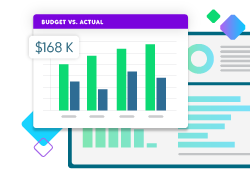Nonprofit Budgeting and Forecasting Made Easy with Fund Accounting Software

It’s budget season, and the spreadsheet chaos has begun. But you want to make this year different.
You want to document your process to save yourself valuable time next budget season. You want to be able to easily report on budgets in a variety of accurate, clear ways without too much fuss, and know what was approved versus what’s been modified. You only have a partial-year budget, but your COO wants projections for the remainder of the fiscal year. And importantly, there are some expense accounts that will need some hard spending limits imposed upon them.
With all the spreadsheet juggling that comes with budget season, it’s easy to forget the primary goal of your organization’s budget: to gain visibility into your organization’s finances and plan for the future.
Luckily, your fund accounting software helps you tackle all these situations. Effective budget documentation and management, copying and forecasting tools, efficient data entry, and enhanced budget checking, transforms your budget into a key diagnostic for your organization. Here’s how you can put them to work for you.
Tools for Pre-Budget Planning
When it comes to budgeting best practices, the foremost advice is to ensure you’ve got the right data in a budget scenario. Scenarios serve as ideas or variations on a plan and align with potential situations that might happen throughout the year as well as the actual budget records you save into your fund accounting software.
Three core general ledger records can provide an entry point for reporting as you build out your scenarios. Beyond the primary Account records that hold budget numbers and distributions, you can also budget for your Grants and Projects, such as programs and activities.
Good questions to ask when considering different budgeting scenarios might include:
- Which parts of the organization will have payroll, utility, or equipment expenses?
- Are we expecting grant revenue? Which programs will receive it?
- What if our event doesn’t raise the amount of revenue we’re hoping for? What if it raises more?
Use your fund accounting software’s robust report types to get deep dives into critical metrics that help build your budget scenarios, such as your program costs, revenue levels, and asset positions. Easily compare previous budgets to actuals, make side-by-side comparisons across a variety of date ranges, and group your results by key categories such as department, division, location, or cost center. Each component of your fund accounting software that holds transaction data provides insight into how best to plan your operations.
Once you’ve answered your big questions, you’ll then need to consider how to populate the budget scenario with totals and distributions. Beyond field-by-field manual entry, there are tools available for expediting the entry process:
- Copy what you want from an existing scenario, whether budget, actuals, or just records
- Forecast based on current-year actuals
- If you use Blackbaud Financial Edge NXT, you can load from external software using the Budget Creator Add-In for Excel
- Use the Load Accounts utility to bring entire sections of your database into the scenario at once.
With data now in a scenario, you’re ready to make the necessary updates that convey your plan.
Fund Accounting Software that Drives Impact
Find out how Blackbaud’s Financial Edge NXT® fits your organization.

Plan for Budget Variables
Forecasting is a simple but powerful way to begin preparing next fiscal year’s budget before the current year’s end. Have you only fleshed out your Program’s expenses for part of the fiscal year while you wait on the status of additional funding? Are event revenue distributions still undetermined, and you’re withholding requests until you know what to expect?
You now have a tool that provides a long ramp for helping enter the next period comfortably in stride. Once the forecasted scenarios are saved into your fund accounting software, they become easily reportable any time you can call on budget variables. Compare revenue and expenses year-over-year for your programs right alongside their budgets in an income statement, or project a view into how your grant revenue might be utilized.
Congratulations! You’ve completed the process of entry and distribution. Once you’ve received approval, it is now the capital-b Budget. Your fund accounting software’s Finalize feature can then be used to indicate that, indeed, these are the approved, “Original budget” variables.
Finalizing ensures that scenarios can’t be freely changed without providing a detailed justification. Though you always hope your budget makes it through the year unchanged, Finalizing also provides peace of mind in case you do need to make adjustments. Life is unpredictable, which is why auditable Adjustment records can be added to Finalized budgets.
Bring these to life in your reporting as the “Adjusted budget” (or “Budget adjustments”) variable. Adjustments can also help with future budgets, shedding light on historical changes that might help you avoid adjusting as frequently later.
Safeguard Against Overspending
Reporting on budgets, making comparisons, and tracking progress is one thing. It might also be extremely important to ensure that certain transaction activity truly does not exceed approved levels. Maybe your technology expenses got away from you last year, and you want to ensure items like printer ink or wireless data usage are restrained. Maybe your event’s catering expenses blew past what was anticipated, and there’s a mandate to cut back next year. You may have an interest in budget figures having more gravity than simply existing as numbers in your fund accounting software, which is where Budget Check tools come in handy.
The Accounts Payable and Fixed Assets subledgers include general-level business rules for enabling safeguards against over-budget spending on your accounts, projects, and grants. In one configuration, warnings will appear system-wide whenever you are about to exceed a budget amount.
For instances where hard caps are necessary, prevent further spending altogether with a different configuration. Sturdy system controls serve as the best guardrails for maintaining cost control and implementing budgetary best practices. You know that your controls are in place to keep certain expenses from getting out of hand.
Your fund accounting software is up to the task of helping you manage your budget and contain costs. Through the available methods of efficient entry, you won’t need to spend as much time putting a budget into the system. With flexible and powerful reporting, you now have a clear sense of how to compare budget figures to actuals. Via the forecasting and finalizing tools, you can project forward in a realistic way while providing transparency. And with budget checking, the power is in your hands to maintain hard spending limits where needed.
If you are ready to see how a fund accounting system built for nonprofit organizations can help you save time this budget season, check out our webinar, 10 Ways Blackbaud Makes Budgeting Easier.

